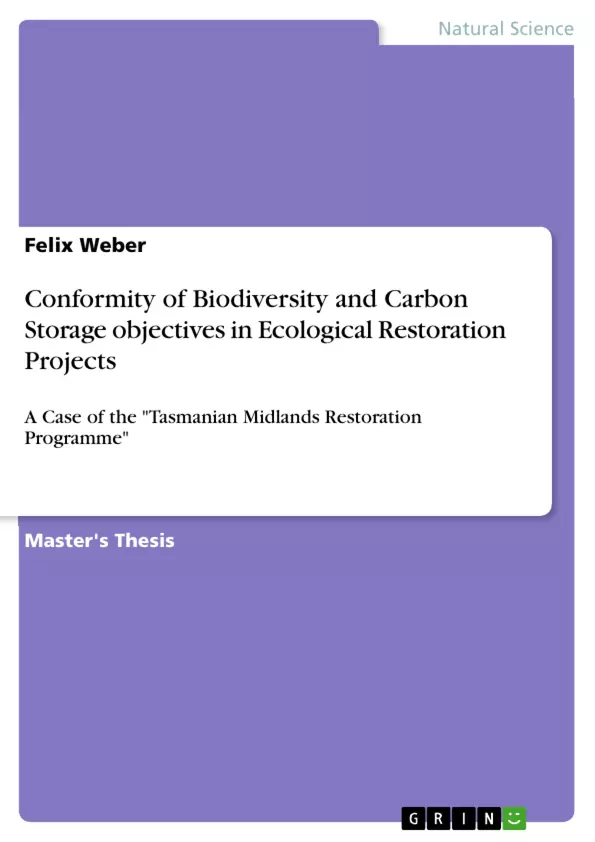Ecological restoration may pursue multiple objectives related to functions and services provided by ecosystems. To understand the different characteristics of restoration programmes prioritising carbon storage and biodiversity conservation this study analysed the case of the TMRP and interviewed 13 stakeholders including project management, partners and landholders. The results revealed that a number of requirements for the two different restoration types are complementary but some specific characteristics particularly related to the selection, composition and diversity of restoration plantings exist.
The effectiveness of restoration depends highly on the commitment of the stakeholders and the study showed that there are different interests between larger landholders, who care more for the general environment, and smaller landholders, who are more concerned about the land´s productivity. Market-based instruments including carbon and biodiversity trading markets could be used to provide further incentives for all restoration stakeholders and enhance the effectiveness of restoration programmes.
Inhaltsverzeichnis (Table of Contents)
- Abstract
- List of Acronyms
- 1. Introduction
- 2. Literature Review - Key concepts and Theory
- 3. Methodology
- 4. Results
- 5. Discussions and Conclusions
- 6. Limitations
- Acknowledgements
- References
- Appendices
- Appendix A: Questionnaire Addressing Greening Australia
- Appendix B: Questionnaire Addressing Project Partners
- Appendix C: Questionnaire Addressing Private Landholders
Zielsetzung und Themenschwerpunkte (Objectives and Key Themes)
This dissertation examines the challenges and opportunities of aligning biodiversity conservation and carbon storage objectives within ecological restoration projects. It specifically analyzes the case of the Tasmanian Midlands Restoration Programme (TMRP), a large-scale restoration initiative in Tasmania, Australia. The research explores the specific requirements of restoration programmes aiming for carbon storage and biodiversity conservation, identifying areas of overlap and divergence. The study also investigates the role of stakeholder engagement and market-based instruments in promoting the success of such programmes.
- The need for ecological restoration in Tasmania, focusing on the decline of temperate eucalypt woodlands
- The contrasting objectives of carbon storage and biodiversity conservation in restoration projects
- The specific requirements of restoration programmes for achieving both carbon storage and biodiversity goals
- The role of stakeholder engagement in the success of restoration programmes
- The potential of market-based instruments, such as carbon and biodiversity trading, to incentivize restoration stakeholders
Zusammenfassung der Kapitel (Chapter Summaries)
- Introduction: This chapter introduces the context of ecological restoration in Tasmania, highlighting the decline of native vegetation and the need for restoration efforts. It introduces the Tasmanian Midlands Restoration Programme (TMRP) and its objectives, emphasizing the potential for carbon storage and biodiversity conservation.
- Literature Review: This chapter provides a comprehensive overview of key concepts and theories related to ecological restoration, particularly focusing on the interplay between carbon storage and biodiversity conservation. It examines existing research and frameworks relevant to the study's objectives.
- Methodology: This chapter outlines the research methodology employed in the study. It details the data collection methods, including interviews with stakeholders and analysis of relevant documents. It also clarifies the specific focus of the research and the data analysis techniques used.
- Results: This chapter presents the key findings of the research. It analyzes the data gathered through interviews and document review, highlighting the specific requirements for carbon storage and biodiversity conservation in the TMRP.
Schlüsselwörter (Keywords)
This research focuses on the intersection of ecological restoration, biodiversity conservation, and carbon storage. Key terms include: Tasmanian Midlands Restoration Programme (TMRP), carbon sequestration, biodiversity hotspots, stakeholder engagement, market-based instruments, carbon trading, biodiversity trading, land use change, and ecosystem services.
- Quote paper
- Felix Weber (Author), 2016, Conformity of Biodiversity and Carbon Storage objectives in Ecological Restoration Projects, Munich, GRIN Verlag, https://www.grin.com/document/373826



